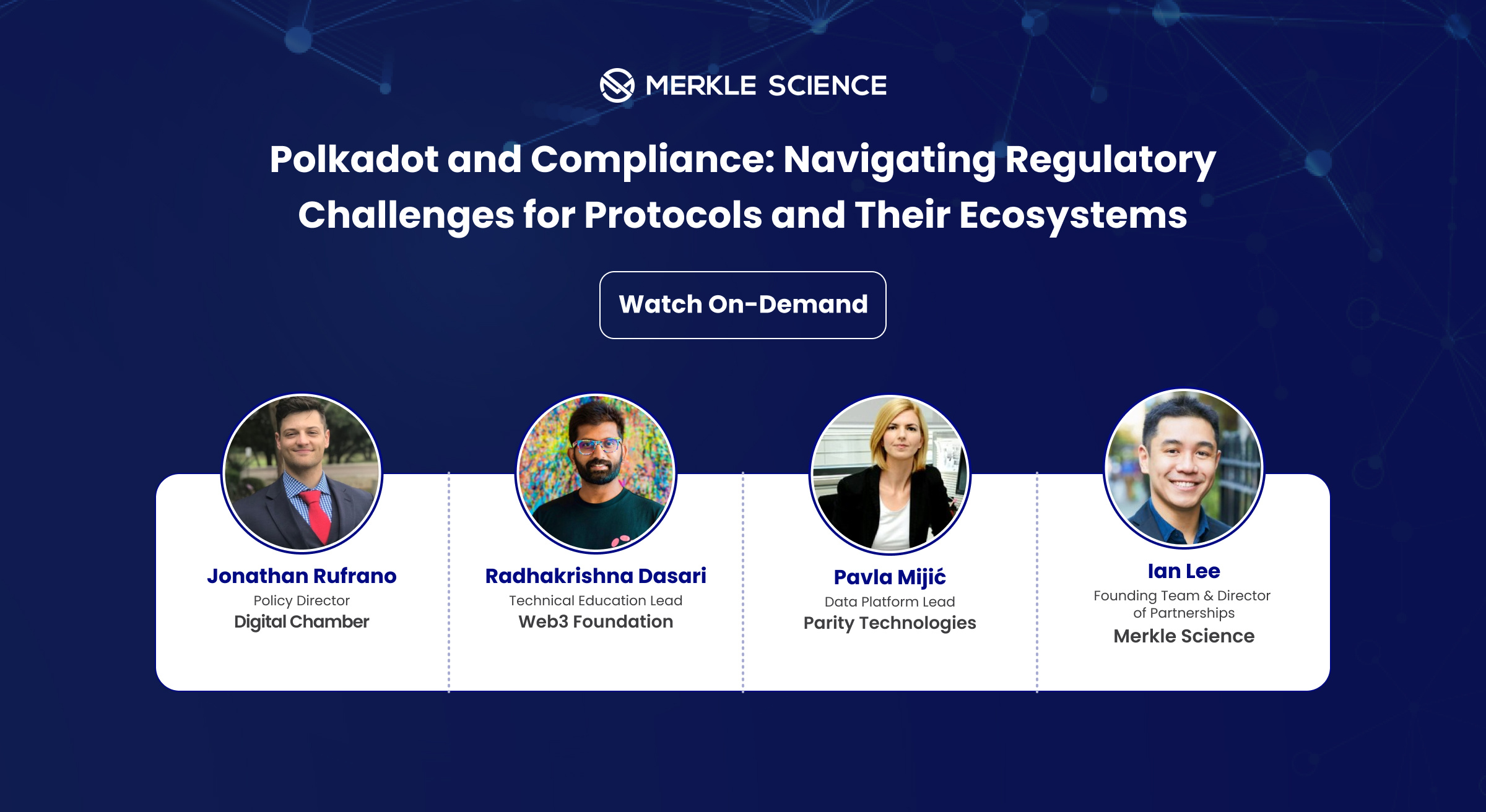Blockchain Compliance on Polkadot: Webinar Recap

Merkle Science

On Tuesday, October 29, Merkle Science hosted a three-hour webinar, Polkadot and Compliance: Navigating Regulatory Challenges for Protocols and Their Ecosystems.
The event featured The Digital Chamber's Policy Director Jonathan Rufrano, the Web3 Foundation's Technical Education Lead Radhakrishna Dasari, Parity Technologies' Data Platform Lead Pavla Mijić, and Merkle Science's Director of Partnerships Ian Lee.
You can watch the webinar on-demand here.
This article will discuss building on Polkadot, evolving regulations about AML and SAR, and compliance best practices, including blockchain analytics for data transparency.
The Polkadot Landscape
Dasari began by sharing Polkadot's current scale. The multichain currently has 51 para chains, 32 million transactions, and 8 million accounts. Polkadot's momentum can be attributed to its unique profile.
"You can engineer a blockchain in a customizable way and put it on Polkadot and run it. So that's why we call Polkadot as a 'heterogeneous multichain' because each individual blockchain runs with different logic and the Polkadot relay chain sort of secures them," said Dasari.
According to Dasari, this customizability accounts for the diversity of use cases on Polkadot—developers are using it for blockchains, rollups, gaming, identity, social networks, and more. "The imagination is yours," he said.
Mijić explained the difference between data in web2 and a web3 technology like Polkadot.
"Blockchain provides complete transparency. So any participant can verify transactions and this enhances the trust among stakeholders. On the other hand, Web2 legacy data sources or traditional databases, their data can be modified or removed by those that have sufficient access rights," she said.
Mijić added that Polkadot's model is incredibly sophisticated. Based on a shared security model, Polkadot provides security for its connected parachains through a proof-of-stake consensus protocol, which minimizes the possibility of attacks and improves the integrity and reliability of cross-chain data.
This shared security model extends to Polkadot's governance. "Every DOT holder (the native token of Polkadot) can propose and vote on upgrades, participate in protocol changes, and submit funding proposals," she said.
Polkadot averages 2.5 new proposals daily, with over 800 runtime upgrades from them.
"By that figure alone, Polkadot is the most upgraded ecosystem to date because it's supported with this on-chain governance that allows seamless workless upgrades and very kind of backward-compatible protocol changes," said Mijić.
How Blockchain Analytics Can Help With the Evolving Regulatory Landscape
The regulatory landscape has evolved at pace with innovations like Polkadot. According to
Rufrano, many organizations must comply with in the United States, including the Financial Action Task Force, the Internal Revenue Service, and the Office of Foreign Assets Control.
Recent developments have revolved primarily around the Securities and Exchange Commission.
"The main conversation around the crypto regulatory environment has focused recently on SEC oversight and whether or not cryptocurrencies are securities and they are issuers and traders and exchangers," said Rufrano.
The SEC has been applying the Howey Test to determine whether a digital asset meets the definition of security and taking enforcement action as needed. In this landscape, some in the industry fear a lack of "regulatory clarity," further compounded by the tensions between the SEC and the Commodity Futures Trading Commission.
As a result, Rufrano advised any business to rigorously self-assess. "Anybody here that's building in the space should consult with their legal team and their compliance team to make sure that they are in compliance and are able to build what they would like to build here in the US," he said.
Rufrano said that Merkle Science will help with suspicious activity reporting (SAR) for businesses with such compliance needs. Under the Bank Secrecy Act, companies must have a risk assessment program, monitor suspicious activity within their platforms, and report any such behavior to local or even international authorities.
"[This is] the largest piece of the puzzle here that I think Merkle Science tools really help out with," Rufrano emphasized.
From there, the webinar transitioned back to Lee, who demonstrated Compass, Merkle Science's fraud and compliance tool for AML, CFT, KYC, and other evolving regulations.
Lee pointed out that the opportunity to enter a new market in crypto can often be an "absolute nightmare" for compliance teams. He gave the example of a business entering into twelve new territories. "What that essentially means for them is that they have to comply with a dozen different regulatory frameworks," said Lee.
Lee advised that Compass simplifies this process through a policy engine with built-in rules based on different jurisdictions that teams can quickly adopt or that can be customized entirely.
"You always have the ability to freely edit any rule that you want, or simply create new rules," said Lee, who emphasized that the monitoring around these rules is then done in real-time and automatically.
Conclusion
As a multichain, Polkadot has taken an innovative approach to security, governance, and data. The regulatory landscape has moved in lockstep with Polkadot and other Web3 innovations—companies must adhere to AML, CFT, KYC, SAR, and other compliance requirements.
A tool like Compass will help businesses address these demands through a fully customizable rules engine that enables real-time, automated monitoring. Contact us for a free demo.


